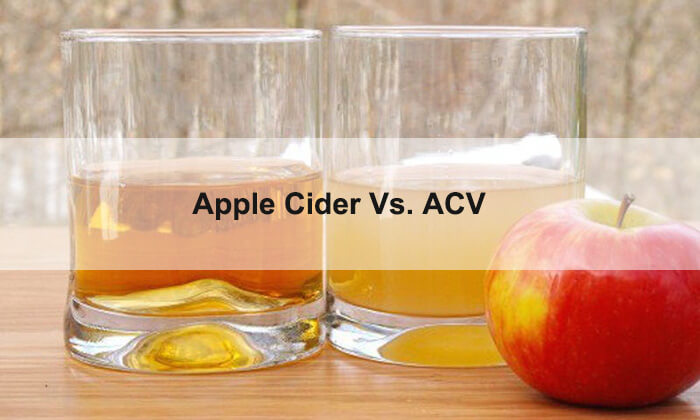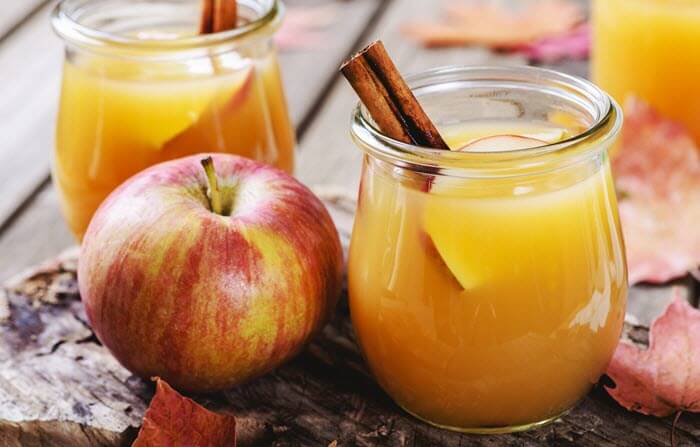Most people have enjoyed a delicious glass of apple cider at some point, and most people also have a bottle of apple cider vinegar in their kitchen. But what’s the difference between the two?
These products have their origins in the same fruit and a similar smell, but the similarities end there. Let’s look at apple cider vs apple cider vinegar so that you can learn the difference.
Table Of Contents
Is Apple Cider the Same as Apple Cider Vinegar?
The short answer is no – apple cider and apple cider vinegar (sometimes called ACV) are two very different things.
When you buy apple cider, you get a delicious drink that comes from crushed apples. But when you buy apple cider vinegar, you get fermented apple cider – which you may or may not want to drink.
Apple Cider | Apple Cider Vinegar |
Made from crushed apples | Fermented apple cider |
Unfiltered & unsweetened | Filtered |
Hard cider contains alcoholic | Contains no alcoholic |
A drink | Used for cooking, disinfectant |
What Is Apple Cider?
Apple cider refers to apple juice – juice from crushed apples, to be specific. It contains no sweeteners and is not filtered to remove pulp or sediment. In many cases, it’s unpasteurized, which can cause it to go slightly fizzy.
Because apple cider will be unfiltered, it typically has a short shelf life. It’s best to store this highly perishable drink in the fridge. You’re most likely to find apple cider in the fall, shortly after the apple harvest, when it’s common at many grocery stores.
You may like: Best Apple Cider Substitute for You
You can drink apple cider when it’s hot or cold. Just make sure to enjoy it in a timely manner, lest you get hard cider.
Apple Cider vs Apple Juice
Apple cider and apple juice often have similar packaging, and you’ll probably hear people use these terms interchangeably. However, they are different drinks.
To get juice from apple skin and flesh, you have to crush or pulverize them. But what happens after you get the juice determines whether you end up with apple juice or apple cider.
If you’re making apple cider, the juice is not filtered, as mentioned above. This means you leave a lot of pulp and sometimes even skin, a process that gives apple cider a deep color and heavier feel.
But if you’re making apple juice, the drink undergoes a filtration process to remove all these particles. The result is a very thin liquid.
If you’ve always drunk apple juice, it may take a while to learn to like apple cider. However, plenty of people prefer apple cider, which is more natural and more filling.
What Is Hard Cider?
If you leave freshly-made apple cider to ferment, you get hard cider – apple cider’s delicious alcoholic cousin.
In the United States, most cider is non-alcoholic unless the label specifically reads “hard.” However, things look a bit different in Europe. If you order cider, in most places you’ll get an alcoholic drink.
What Is Apple Cider Vinegar?
Apple cider vinegar refers to apple cider that has been fermented twice. It’s primarily a cooking ingredient, and it’s readily available in grocery stores. Some people also use apple cider vinegar as a disinfectant.
Further reading: Does Apple Cider Vinegar Go Bad?
How is Apple Cider Vinegar Made?
All vinegar, whether it’s apple cider, white, balsamic, or rice vinegar, is made similarly: by fermenting water and acetic acid. You can use different acetic acids to achieve the various flavor profiles, such as:
- Rice
- Grains
- Potatoes
- Fruit
Apple cider vinegar will be made just like other vinegars, except that you start with apple cider instead of other fruit juices.
- You mix crushed apples with yeast or sugar and let them sit for a few weeks. This process ferments the juice and creates sugar alcohol.
- Then apple cider vinegar goes through an additional fermentation process.
- Bacteria are added, which transitions any alcohol into something called “acetic acid.”
And voila! You now have apple cider vinegar, which you can find in both pasteurized and raw versions.
Apple Cider Vinegar vs Regular Vinegar
It’s easy to spot the difference between regular vinegar and apple cider vinegar.
Regular vinegar will be clear, while apple cider vinegar will be brown. If you taste them, you’ll also notice very distinct flavor profiles; the fruity apple notes really come through in apple cider vinegar.
Both are household staples used for health and cleaning. But if you want to use vinegar for disinfecting, it’s best to use regular vinegar, which is cheaper and doesn’t have such a potent smell.
You May Like: Apple Cider Vinegar Vs. White Vinegar
Cider Vinegar vs Apple Cider Vinegar
Cider vinegar may refer to apple cider vinegar, but in some cases it’s different.
Some cider vinegars are made with apple cider vinegar as a base, but they also include various fruit juices/ciders. You can find things like raspberry cider vinegar or strawberry cider vinegar, but manufacturers often prefer the catchall “cider” label instead of specifying the ingredients.
Health Benefits of Apple Cider Vinegar
Many people tout apple cider vinegar for its many health properties [1]. It has antimicrobial and antioxidant properties, and for centuries, it’s been a popular home remedy for many ailments.
There’s also evidence to suggest that apple cider vinegar may have certain health benefits:
- As a weight loss aid
- To lower blood sugar
- To help reduce the symptoms of diabetes
- To calm acid reflux
- To help reduce cholesterol
So how do you reap the benefits?
The best way to incorporate it into your diet is through cooking. You can add it to salad dressings, marinades, or homemade mayo. Some people add a dash to sauces or stews for some extra zing.
If you’re feeling more adventurous, you can also drink apple cider vinegar – just make sure to dilute it with water to make it more palatable.
A good way to ease into things is by mixing 1 or 2 teaspoons of apple cider vinegar in a large glass of water. As you get used to it, you can work your way up to having 1 to 2 tablespoons.
Recipes with Apple Cider/Apple Cider Vinegar
Homemade Apple Cider And Apple Cider Cupcakes
Honey Garlic Chicken Breast
Wrapping Up
Now you know the difference between apple cider vinegar and plain apple cider.
To sum up, apple cider refers to unfiltered apple juice, and apple cider vinegar refers to fermented apple cider. Whether you’re drinking apple cider or using apple cider vinegar in a salad dressing, each has a special place in our homes.



